Dinosaur Hunter Diaries #109: Reprinted by popular demand!
Turok: Son of Stone #57
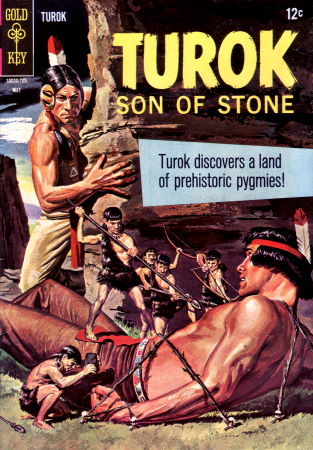
A look at Turok across the pond, particularly his far-out exploits south of the border!
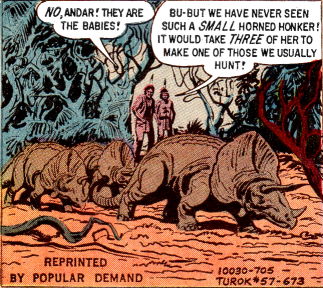
Yet another issue dedicated solely to reprints, this time The Slave of the Merciless Masters and The Land of No Return from issue #17. Once again the artwork is fully recoloured; a little more reliant on block colouring this time around, but also a little more fanciful with its palette in some cases. This is also the first reprint to edit the material — The Land of No Return is quite mercilessly cut down from a 13-page story to only 7!
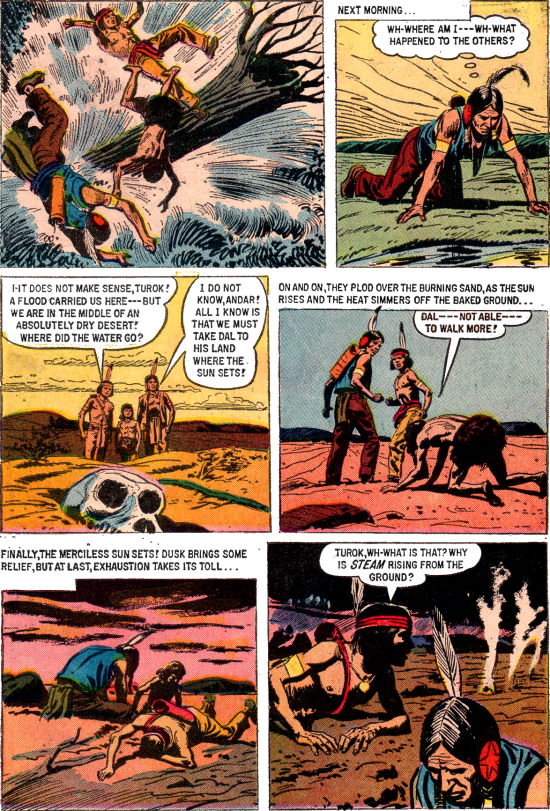
All the beats remain the same, but the previously meandering story is trimmed down to the bare essentials, meaning each of the locales are visited for only a few panels each; the extract above is comprised of panels from four separate pages. I’d argue it’s better that way, though I’m not a huge fan of that story to begin with.
This is to make way for side-features: Young Earth dramatises the death and eventual finding of Java Man, while the text feature focuses on Pattee’s Cave, theorising it to be of Phoenician origin…
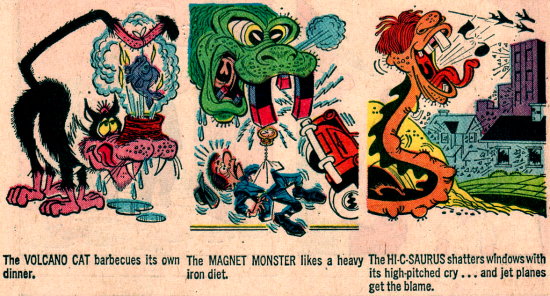
… and alongside them is a new feature, the Gold Key Comics Club! The gates of communication are finally opened to readers, demanding their jokes and opinions, as well as an answer to the question we all want to be asked: can you create a monster? These features will be expanded upon in future issues once letters start flooding in, but for this dry-run they’ve got examples from in-house artists to show the kind of malarkey they’re after.
Although an American production, Turok saw itself exported all across the globe in a variety of languages, exposing the Son of Stone to all manner of audiences. I apparently thought it’d be a lark to look at some of the most notable regional variants, and months later I’m still editing this. Please humour me and my debilitating flights of fancy.
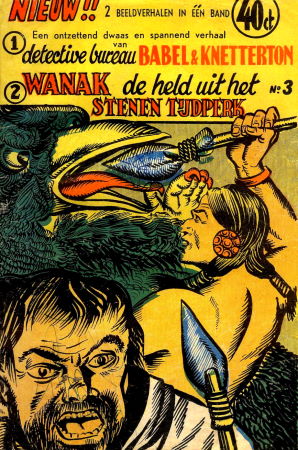
Among the earliest exports I’m aware of is its extremely short-lived 1957 run in the Netherlands, under the new title of Wanak De Held Uit Het Stenen Tijdperk… or sometimes Wanak: De Eerste Koning Der Aarde, roughly translated as “Wanak: The Hero of the Stone Age” and “The First King of the Earth” respectively. As you might have gathered, Turok himself saw a new moniker in the Dutch language (not counting the times his name gets misspelt as Wanik!), with Andar renamed to Lan, and Lanok now Berek.
What’s unique about this reprint is that it’s not even a reprint; it’s a complete redraw! Said to be the uncredited work of young artist Albert Survie, all of the art has been traced in thick ink, with new panel proportions to accommodate its monochrome presentation and Dutch hand-lettering! Issue #4’s The Smilodon, regaled in issue 3 of Wanak, has some small changes to reduce it from 17 pages to 16, but otherwise hits all the beats of the original strip… all except for Turok’s feather, which is curiously absent. The eagle asked for better royalties.
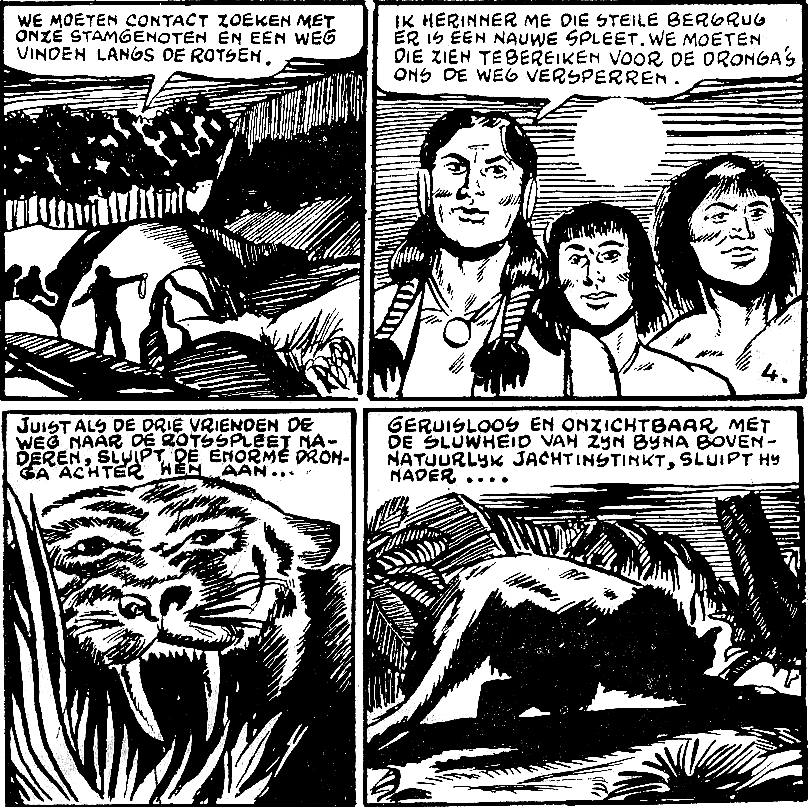
Wanak: De Held Uit Het Stenen Tijdperk No.3 (1957)
No, this is because the characters are simply members of a prehistoric tribe fighting for survival, with no mention of the outside world at all, as far as I can tell. Turok and Andar’s positions as Native Americans lost in a primeval land appears to be totally glossed over. It’s a twist in the tale that perhaps means nothing to international markets without that cultural background, and easy to ignore without the introductory first issue.
1957 seems extremely early to be reprinting stuff, too, so reconfiguring their frequent run-ins with Lanok as a permanent staple of their team isn’t a broad leap. Not that the series was particularly long-lived; there’s shockingly little information on the series online, with only three issues containing one story and one irrelevant backup each before quietly slinking out of existence.
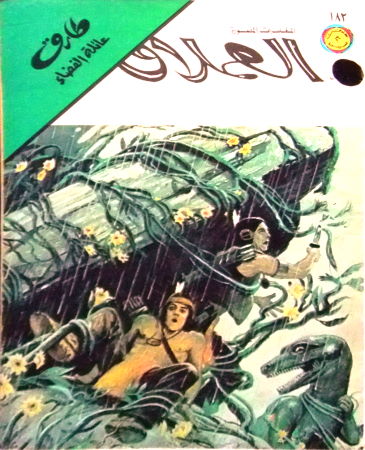
طارق العملاق كومكس
Turok Al Omlaak #182 (1980)
image from ajconsignments07
The ’60s and ’70s were perhaps Turok’s boom for exports, hitting all English-speaking markets and a good chunk of foreign language releases. It saw two separate releases in Germany across two decades; first as a standalone black-and-white comic (Turok: Sohn Der Steinzeit), and again as part of the anthology series, Die Actionhelden, alongside other Gold Key heavy hitters — Magnus: Robot Fighter, Dagar the Invincible, and Space Family Robinson. Stories were also printed wildly out of order; a common occurrence among publisher Condor Verlag, but hardly unexpected. Only in the second book does it reprint Turok’s origin story, The World Below, as the very last story in the volume.
Even Arabic countries such as Leban found interest in Turok, parsed in the native tongue as “Tarek” or “Tariq”. With its right-leaning script, the comics were flipped horizontally and rendered in black and white, published as both traditional floppies and thick-backed Giant Comics (Al Omlaak), often alongside other adventures trips like Tarzan.
Turok: Son of Stone was also published in Mexico by Editorial Novaro, under the title of Turok: El Guerrero De Piedra, literally “The Warrior of Stone”, though it wasn’t a straightforward reprint by any stretch of the imagination. I’ve read all 130 issues of Son of Stone (and then some!); by no means do I remember them all with clarity, but I can look at a few pages, check my notes, and have a rough idea of where they came from.
El Guerrero De Piedra goes against all that. A typical issue looks every part like a story I’ve read before, just on the verge of my memory, too blurry and indistinct to be truly identified. All the recognisable trappings are there; our heroes have run-ins with the natives, employing the same bevy of traced poses we’ve seen from Alberto Giolitti and other artists, among other familiar stylistic elements…
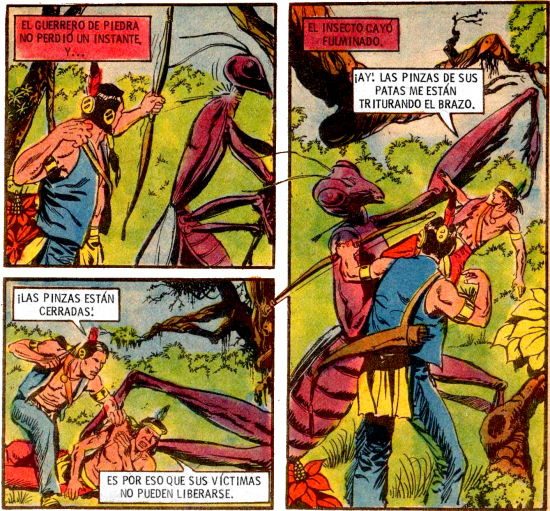
Turok: El Guerrero De Piedra #D (November 1978)
… but then somewhere along the line, Turok and Andar are suddenly three pages deep into a fight with a colossal megalodon, or find themselves protecting a woman’s honour from a tribe of tiger-men. It’s just familiar enough to make me think, huh, maybe I did forget about the time they fought a bunch of Vikings… and yet there’s something so distinctly off about it as well, even in the tamest of tales.
Reading my first few issues of it almost felt like a waking nightmare, or a creepypasta if you’re so inclined. It never treads far from the traditional trappings of Turok… yet it never falls totally in line with what I’m acquainted with. The action is a lot more explosive and chaotic than usual. Our heroes are either battling off dozens of foes at a time, or find themselves so many allies they get lost among the crowd, struggling for page space.
All that, and there’s a greater diversity of threats than the classic strip; there’s dinosaurs by the barrelful, but also tigers, snakes, giant insects, and not just human threats, but threats from out of this world! But I’m getting ahead of myself.
There’s a certain ‘bootleg’ vibe to the affair, though by all accounts (that is to say: not many) it’s all proper and legal, a rightfully licensed product and acting within their rights. It’s the look that feels off; the printing’s a bit cheaper than what we’re used to even from Gold Key, but the new stories often play havoc with the traditional six-panel grid, presenting panels that are haphazard and chaotic, a jarring sight after nearly thirty years of routine tradition.
One could argue this style is a better usage of the comics medium, and particularly apt with the wild battles and turbulent plot twists common to the Mexican storylines. That, and although competent, the new covers have that certain off-model airbrushed vibe that’s associated with so many bootleg action figures and license-infringing murals. To be fair, that’s probably more damning of western culture and under what contexts we’re exposed to Mexican art.
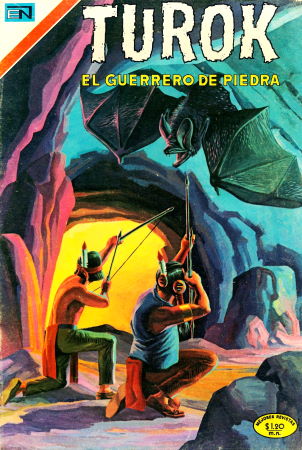
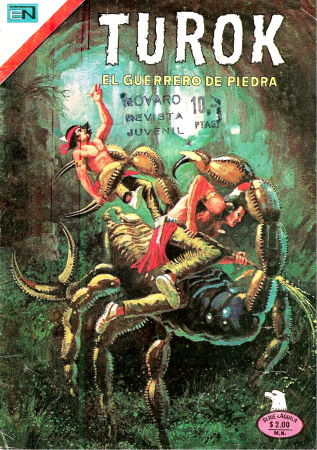
Turok: El Guerrero De Piedra #19 (January 1 1971 / Turok: El Guerrero De Piedra #95 (July 28 1975)
The brand new painted illustrations, at a glance, look an awful lot like the Gold Key house style, but at closer inspection reveal their own idiosyncrasies. Some covers are collages of existing material, or paint-overs of interior panel art, while many are completely original concoctions, up there with the originals in sheer “I gotta see what this is about!” value.
As with the original series, some covers are reused across multiple issues, and often times the cover depicts an outrageous, unholy event that has no bearing on the stories inside. Portions from renowned fantasy paintings were often traced to spice up Turok’s skirmishes, resulting in him squaring off against the works of Frank Frazetta on multiple occasions! Sadly not representative of the issue’s contents, of course. Rip Jagger’s Dojo covers some of the most interesting highlights in his “Turok – Son of Frazetta” series: [I] [II] [III] [IV]
With all this discussion of its differences, you’d think Mexico never even saw the original Turok: Son of Stone! Despite appearances, sometimes the original Gold Key comics made it across unmutated, complete with translations of the side features such as Young Earth.
These were usually printed under various other banners, among them Aventura and Domingos Alegres (comics with a different theme every issue, not unlike Dell’s own Four Color Comics), with the mainline El Guerrero De Piedra reserved for the bonkers brand-new material… though it would schedule an ordinary reprint every four issues, looking a lot more subdued in comparison to its barmy brethren.
There are a number of recurring themes in the Mexican stories that make them stand apart from the English originals, perhaps most notable of all is the larger variety of wildlife! El Guerrero De Piedra began reprinting from Gold Key issue #61 onwards, by which point it had been established Lost Valley was home only to reptiles from the prehistoric period.
But the new stories borrow from the series’ entire bestiary, including mastodons, smilodons, and staples of classic adventure that Turok has otherwise never faced off against: bears, sharks, scorpions, and a multitude of giant insects! It’s uncanny to watch the mainline series slowly establish its canon and ground rules, only to see this take a different tack entirely.
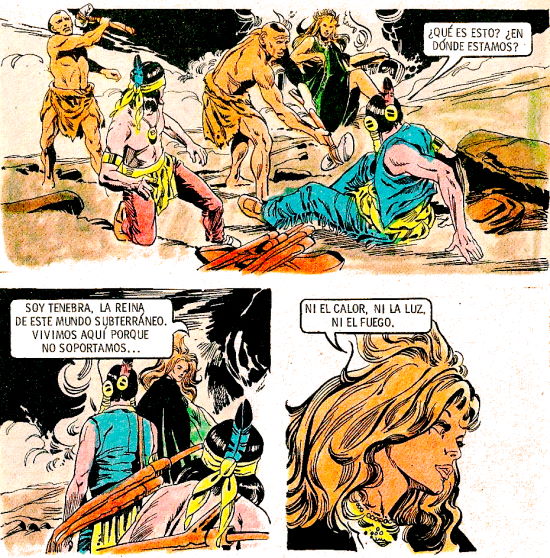
Turok: El Guerrero De Piedra #110 (February 24 1976)
Women appear a lot more frequently in the Mexican stories; not always with great contributions, but it’s a darn sight better than the Gold Key comics, which haven’t seen a significant female character since issue #2’s Yellana and that one girl they threw in a volcano. Turok and Andar find themselves helping folks a lot more in these new stories, completely ignoring Paul S. Newman’s isolationist themes, and having a damsel show up to explain their predicament helps move the story along.
Several stories will find an excuse to put Andar on the sidelines so Turok can share the spotlight with a dame, and even engage in a modest bit of romance, before she ultimately perishes or they’re forced to go their separate ways. Only late in the Gold Key run does it acknowledge some would consider Turok a dish, but only in a half-hearted “as if that’ll ever happen!” notion; he’s otherwise strictly chaste.
Far-out locales and denizens pop up with startling frequency in El Guerrero De Piedra, depicting the Lost Valley as a true melting pop of ancient cultures and civilisations, and some not-so-ancient. Dudes in animal suits are a frequent colourful threat, alongside marble cities, stone kingdoms, and other fare that’s a common sight in adventure yarns of olde, but an uncanny sight in the formula-driven Turok tales.
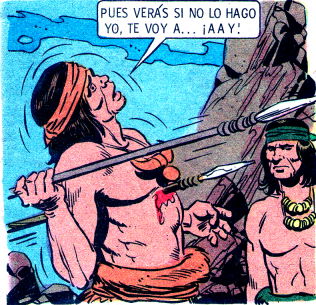
Turok: El Guerrero De Piedra #68 (January 28 1974)
The Mexican series is also far less shy about depicting violence and bloodshed. Turok won’t just shoot things with poison arrows, he’ll fling a knife into a buffalo’s skill and kill it instantly! Death is often depicted with oozing wounds, an unexpected and somewhat grisly sight against the familiar trappings of otherwise bloodless combat. With all the pointy weapons abounds in Lost Valley, this is the first time we actually see the chest-piercing nastiness involved with spears. Mexicans can take it, dude.
Just like Dell Comics, the writers and artists involved in these stories are almost unanimously uncredited, and there’s sadly not the same level of study given to these old works as there is in the US of A. The one credit I can find, artist Javier Manzano Torres in issue #245, has no relevant online records as far as I can find, leaving his history, whereabouts, and other works a mystery.
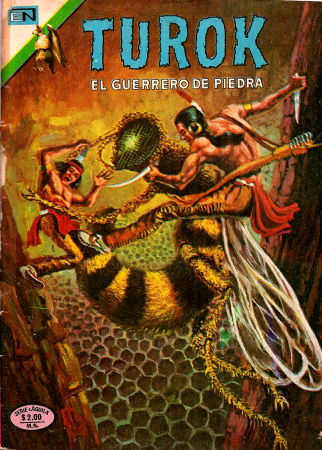
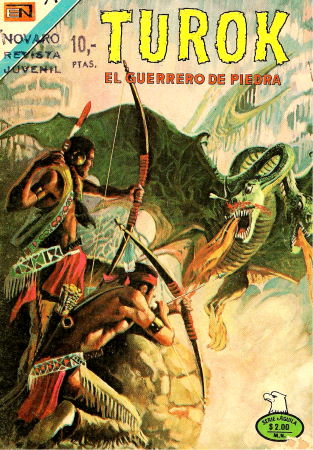
Turok: El Guerrero De Piedra #89 (April 20 1975) / Turok: El Guerrero De Piedra #94 (July 14 1975)
Issue #245!? It goes higher than that, believe me! As a bi-weekly release compared to the bi-monthly schedule in the States, El Guerrero De Piedra demanded new, original material to keep up the pace, resulting in anywhere from two to five Mexico-original issues before it would reprint the next issue of Son of Stone. Gold Key’s issue #61 wasn’t even printed until the fourth issue of El Guerrero De Piedra, and by the time El Guerrero De Piedra #93 reprinted issue #83 in 1975, it had built an extra year of buffer just through the sheer number of original stories!
As far as I’m aware, original content for Mexican reprints was not a common practise, yet the times it did occur resulted in a surge of all-new material that often outpaced the very comic it was importing! This became most evident when the comics scene discovered what they believed to be a parallel continuity in Mexico’s Spider-Man series, El Sorprendente Hombre Arana, wherein Gwen Stacy survived and remained a central figure years after her death had occurred in the States. Spoilers for a comic old enough to be a granddad, by the way.
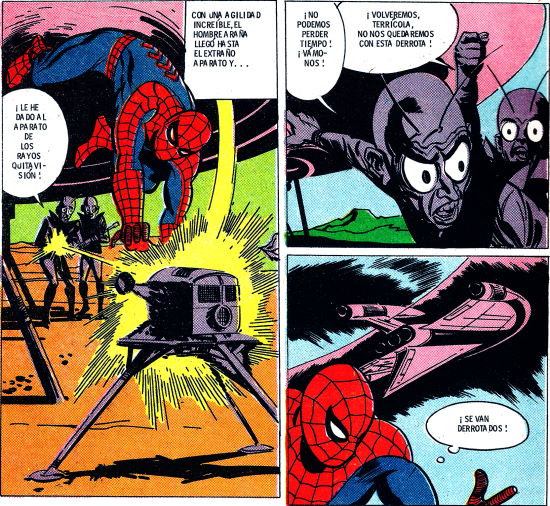
El Sorprendente Hombre Arana #157 (April 6 1973)
Of course, what actually happened was Mexican backups far outnumbered the original monthly material that the stories leading up to her death were pushed farther and farther back, telling new stories that commonly featured extraterrestrial adversaries and also Gwen’s shapely derrière.
Some comics blogs may spotlight the unique and often off-putting original covers these overseas editions employ, but there’s more to these foreign ‘reprints’ than meets the eye… and it’s simply not as well-documented as one would hope. It’s a dickens finding scans, for a start, and not nearly the same prevalence of second-hand copies floating around either.
It doesn’t help when the numbering is a trifle barmy, too. Many online sources overlook the various imprints these comics fell under, simply numbering them as, say, “Turok #80” with no regards whether it’s under the El Guerrero De Piedra or Domingos Allegres banner, or even just lifting the number from the Gold Key version based solely on the cover. Matters are complicated even further when these stories filtrated into Colombia, released under the same title by publisher Epucol, but with completely different numbering! Does the Colombian version feature original stories, or is it all lifted from the Mexican reprint? Who knows, nobody bloody talks about it!
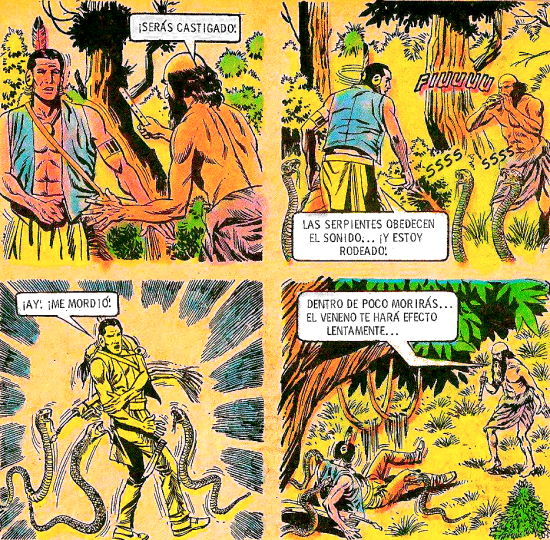
Turok: El Guerrero De Piedra #100 (October 7 1975)
Based on the abundance of original Spider-Man and Turok tales across the pond, one might be led to believe Mexico is a well of untapped superhero stories… but it was more a sign that those two series were popular and in demand. Editorial La Prensa, who published El Sorprendente Hombre Arana, don’t appear to have given the same luxury treatment to their other Marvel reprints, nor Editorial Novaro to their DC licenses.
Everything else, however, Novaro appeared to treat as fair game: Tarzan, Red Ryder, Korak, even Hopalong Cassidy, all received issue counts numbering in the hundreds — possibly bordering on the thousands! — so either Novaro knew how to make the most of a license, or creating a job market for local artists and writers was too good to pass up, legalities be damned.
Online price guides don’t offer much for El Guerrero De Piedra, even in near-mint condition, yet the comics aren’t exactly common from the looks of things. Cover scans are plentiful, but documentation of their contents is hard to come by, which is frustrating when the English comics have been so exhaustively discussed and, er, preserved online. When the painted covers feature some truly wild scenes, like Turok fighting a Roman centurion, it’s all the more galling that it can’t be found with ease. The modern age of access to information and also unbridled piracy has spoiled us all.
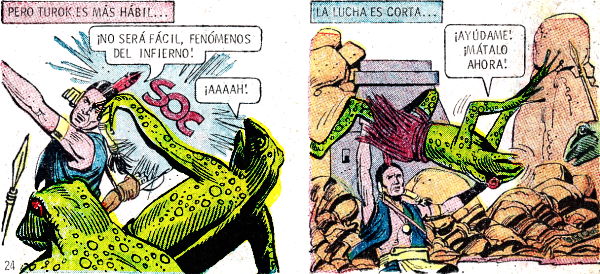
Turok: El Guerrero De Piedra #31 (January 3 1972)
Turok: El Guerrero De Piedra has never been reprinted since its original release, and is barely acknowledged at all in English-speaking circles, but in its home country it remains a favourite among fans of classic comics, apparently, often revered alongside Mexican greats like Kalimán: El Hombre Incredible.
It’s a bummer knowing such a well of content is barely documented at all, though with nearly three hundred issues to its name, it’d be a tall order to do it exhaustively. Adding it in its entirety to Dinosaur Hunter Diaries’ coverage might be asking a bit much, but maybe we’ll see some highlights down the road…?

One question I have in regard to Mexican Turoks is: where can you buy thhem?
I’d love to know, personally! They show up occasionally on eBay or on regional sites like Mercado Libre, but they rarely ship outside of South America so you’d probably have to order through a proxy. Scans are probably the most accessible means of reading them, I’m afraid. I’d love to track down some of the missing issues, but it’s hard enough finding them for sale, and harder to actually acquire them…!
I’ve seen, even gotten a very few issues on ebay. Most are overpriced. I can’t order from Mercado Libre. This may sound stupid, but what’s a proxy?
Proxy services order stuff on your behalf from overseas stores and ship them your way, with service fees on top. I’m only acquainted with them for buying from Japan, and a quick search doesn’t bring up results for dedicated services that export from Mexico — or at least, none with positive reviews.